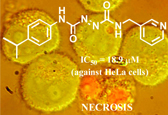Synthesis and Biological Activity of New Diazenedicarboxamides as Potential Anticancer Agents
Keywords:
Diazenedicarboxamides, tumor cells, anticancer drugsAbstract
To increase the effectiveness of cancer treatment, more effective anti-cancer drugs, as well as the new improved strategies of cancer treatment, are urgently needed. Our previous results have shown that various diazenes are cytotoxic to different tumor cells and can even revert the resistance to cisplatin and vincristine. We also demonstrated that unsymmetrical diazenedicarboxamides 1 and 2 exhibited promising cytotoxicity. The aim of the present study was to synthesize new diazenedicarboxamides with acceptable solubility and good cytotoxicity. Here we report the synthesis and biological evaluation of new N,N’-disubstituted diazenedicarboxamides. We found that a modification of either 1 or 2 led to the more active compounds. The most effective among them was diazenedicarboxamide 11, which can be considered as a new potential anticancer agent for the tumors of different origin, as well as for the drug resistant tumors.

Downloads
Published
Issue
Section
License
Except where otherwise noted, articles in this journal are published under the Creative Commons Attribution 4.0 International License
